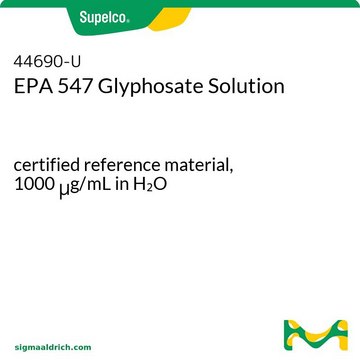P9556
N-(Phosphonomethyl)glycine
BioReagent, suitable for plant cell culture
Synonym(s):
Glyphosate
Sign Into View Organizational & Contract Pricing
All Photos(2)
About This Item
Linear Formula:
(HO)2P(O)CH2NHCH2CO2H
CAS Number:
Molecular Weight:
169.07
Beilstein:
2045054
EC Number:
MDL number:
UNSPSC Code:
10171502
PubChem Substance ID:
NACRES:
NA.71
Recommended Products
product line
BioReagent
Quality Level
form
powder
technique(s)
cell culture | plant: suitable
mp
230 °C (dec.) (lit.)
application(s)
agriculture
shipped in
ambient
SMILES string
OC(=O)CNCP(O)(O)=O
InChI
1S/C3H8NO5P/c5-3(6)1-4-2-10(7,8)9/h4H,1-2H2,(H,5,6)(H2,7,8,9)
InChI key
XDDAORKBJWWYJS-UHFFFAOYSA-N
Looking for similar products? Visit Product Comparison Guide
General description
Glyphosate (N-(phosphonomethyl)glycine) (sold commercially as Roundup) is the most widely used broad-spectrum systemic herbicide in the world. Consequently, the environmental effects of glyphosphate and its mechanism of action are an important area of active research.
Biochem/physiol Actions
Glyphosate (N-[phosphonomethyl] glycine) is the herbicide form of the isopropylamine salt of glyphosate.
Glyphosphate inhibits the shikimate pathway-dependent synthesis of the aromatic amino acids tyrosine, tryptophan and phenylalanine at the growing points of plants.
Preparation Note
Signal Word
Danger
Hazard Statements
Precautionary Statements
Hazard Classifications
Acute Tox. 4 Dermal - Aquatic Chronic 2 - Eye Dam. 1
Storage Class Code
11 - Combustible Solids
WGK
WGK 2
Flash Point(F)
Not applicable
Flash Point(C)
Not applicable
Personal Protective Equipment
dust mask type N95 (US), Eyeshields, Gloves
Choose from one of the most recent versions:
Already Own This Product?
Find documentation for the products that you have recently purchased in the Document Library.
Customers Also Viewed
Influence of glyphosate (N-(phosphonomethyl) glycine) on performance and selected parameters in broilers
Kubena L F, et al.
Poultry Science, 60(1), 132-136 (1981)
Apoorva Ravishankar et al.
Environmental pollution (Barking, Essex : 1987), 262, 114359-114359 (2020-05-24)
Glyphosate-based herbicides, the most extensively used herbicides in the world, are available in an enormous number of commercial formulations with varying additives and adjuvants. Here, we study the effects of one such formulation, Credit41, in two genetically diverse yeast strains.
Amy Lavin Williams et al.
Journal of toxicology and environmental health. Part B, Critical reviews, 15(1), 39-96 (2011-12-29)
Glyphosate is the active ingredient of several widely used herbicide formulations. Glyphosate targets the shikimate metabolic pathway, which is found in plants but not in animals. Despite the relative safety of glyphosate, various adverse developmental and reproductive problems have been
Hugh J Beckie
Pest management science, 67(9), 1037-1048 (2011-05-07)
This review focuses on proactive and reactive management of glyphosate-resistant (GR) weeds. Glyphosate resistance in weeds has evolved under recurrent glyphosate usage, with little or no diversity in weed management practices. The main herbicide strategy for proactively or reactively managing
Stephen O Duke et al.
Pest management science, 64(4), 319-325 (2008-02-15)
Since its commercial introduction in 1974, glyphosate [N-(phosphonomethyl)glycine] has become the dominant herbicide worldwide. There are several reasons for its success. Glyphosate is a highly effective broad-spectrum herbicide, yet it is very toxicologically and environmentally safe. Glyphosate translocates well, and
Our team of scientists has experience in all areas of research including Life Science, Material Science, Chemical Synthesis, Chromatography, Analytical and many others.
Contact Technical Service












